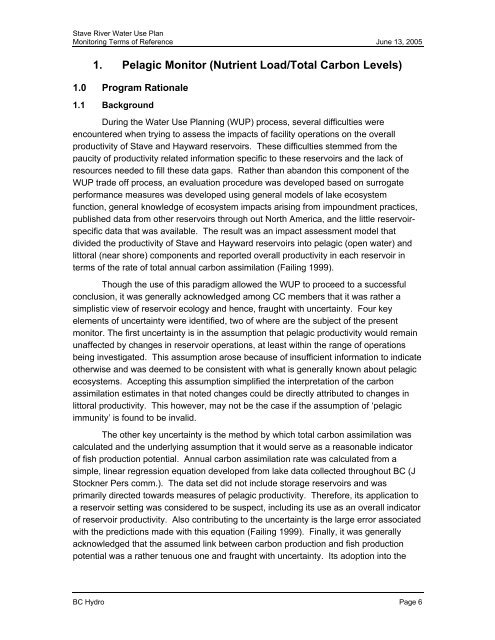Stave River Water Use Plan - BC Hydro
Stave River Water Use Plan - BC Hydro
Stave River Water Use Plan - BC Hydro
Create successful ePaper yourself
Turn your PDF publications into a flip-book with our unique Google optimized e-Paper software.
<strong>Stave</strong> <strong>River</strong> <strong>Water</strong> <strong>Use</strong> <strong>Plan</strong><br />
Monitoring Terms of Reference June 13, 2005<br />
1. Pelagic Monitor (Nutrient Load/Total Carbon Levels)<br />
1.0 Program Rationale<br />
1.1 Background<br />
During the <strong>Water</strong> <strong>Use</strong> <strong>Plan</strong>ning (WUP) process, several difficulties were<br />
encountered when trying to assess the impacts of facility operations on the overall<br />
productivity of <strong>Stave</strong> and Hayward reservoirs. These difficulties stemmed from the<br />
paucity of productivity related information specific to these reservoirs and the lack of<br />
resources needed to fill these data gaps. Rather than abandon this component of the<br />
WUP trade off process, an evaluation procedure was developed based on surrogate<br />
performance measures was developed using general models of lake ecosystem<br />
function, general knowledge of ecosystem impacts arising from impoundment practices,<br />
published data from other reservoirs through out North America, and the little reservoirspecific<br />
data that was available. The result was an impact assessment model that<br />
divided the productivity of <strong>Stave</strong> and Hayward reservoirs into pelagic (open water) and<br />
littoral (near shore) components and reported overall productivity in each reservoir in<br />
terms of the rate of total annual carbon assimilation (Failing 1999).<br />
Though the use of this paradigm allowed the WUP to proceed to a successful<br />
conclusion, it was generally acknowledged among CC members that it was rather a<br />
simplistic view of reservoir ecology and hence, fraught with uncertainty. Four key<br />
elements of uncertainty were identified, two of where are the subject of the present<br />
monitor. The first uncertainty is in the assumption that pelagic productivity would remain<br />
unaffected by changes in reservoir operations, at least within the range of operations<br />
being investigated. This assumption arose because of insufficient information to indicate<br />
otherwise and was deemed to be consistent with what is generally known about pelagic<br />
ecosystems. Accepting this assumption simplified the interpretation of the carbon<br />
assimilation estimates in that noted changes could be directly attributed to changes in<br />
littoral productivity. This however, may not be the case if the assumption of ‘pelagic<br />
immunity’ is found to be invalid.<br />
The other key uncertainty is the method by which total carbon assimilation was<br />
calculated and the underlying assumption that it would serve as a reasonable indicator<br />
of fish production potential. Annual carbon assimilation rate was calculated from a<br />
simple, linear regression equation developed from lake data collected throughout <strong>BC</strong> (J<br />
Stockner Pers comm.). The data set did not include storage reservoirs and was<br />
primarily directed towards measures of pelagic productivity. Therefore, its application to<br />
a reservoir setting was considered to be suspect, including its use as an overall indicator<br />
of reservoir productivity. Also contributing to the uncertainty is the large error associated<br />
with the predictions made with this equation (Failing 1999). Finally, it was generally<br />
acknowledged that the assumed link between carbon production and fish production<br />
potential was a rather tenuous one and fraught with uncertainty. Its adoption into the<br />
<strong>BC</strong> <strong>Hydro</strong> Page 6
















